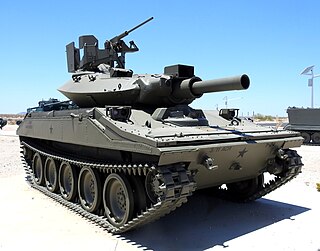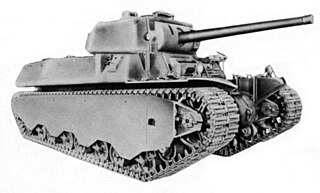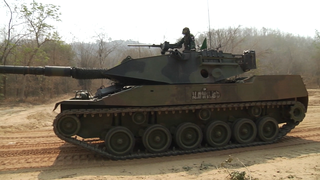
A tank destroyer, tank hunter, tank killer, or self-propelled anti-tank gun is a type of armoured fighting vehicle, armed with a direct fire artillery gun or missile launcher, designed specifically to engage and destroy enemy tanks, often with limited operational capacities.

An infantry fighting vehicle (IFV), also known as a mechanized infantry combat vehicle (MICV), is a type of armoured fighting vehicle used to carry infantry into battle and provide direct-fire support. The 1990 Treaty on Conventional Armed Forces in Europe defines an infantry fighting vehicle as "an armoured combat vehicle which is designed and equipped primarily to transport a combat infantry squad, and which is armed with an integral or organic cannon of at least 20 millimeters calibre and sometimes an antitank missile launcher". IFVs often serve both as the principal weapons system and as the mode of transport for a mechanized infantry unit.

The M551 "Sheridan" AR/AAV was a light tank developed by the United States and named after General Philip Sheridan, of American Civil War fame. It was designed to be landed by parachute and to swim across rivers. It was armed with the technically advanced but troublesome M81/M81 Modified/M81E1 152 mm gun/launcher, which fired both conventional ammunition and the MGM-51 Shillelagh guided anti-tank missile.

The BMP-1 is a Soviet amphibious tracked infantry fighting vehicle. BMP stands for Boyevaya Mashina Pyekhoty 1, meaning "infantry fighting vehicle, 1st serial model". The BMP-1 was the first mass-produced infantry fighting vehicle (IFV) of the Soviet Union. It was called the M-1967, BMP and BMP-76PB by NATO before its correct designation was known.

The M60 is an American second-generation main battle tank (MBT). It was officially standardized as the Tank, Combat, Full Tracked: 105-mm Gun, M60 in March 1959. Although developed from the M48 Patton, the M60 tank series was never officially christened as a Patton tank. The US Army considered it a "product-improved descendant" of the Patton tank's design. The design similarities are evident comparing the original version of the M60 and the M48A2. It has been sometimes informally grouped as a member of the Patton tank family. The United States fully committed to the MBT doctrine in 1963, when the Marine Corps retired the last (M103) heavy tank battalion. The M60 tank series became America's primary main battle tank during the Cold War. Over 15,000 M60s were built by Chrysler. Hull production ended in 1983, but 5,400 older models were converted to the M60A3 variant ending in 1990.

The M18 Hellcat is a tank destroyer that was used by the United States Army in World War II and the Korean War. A top speed of up to 55 mph (89 km/h) was attained by keeping armor to a minimum, using the innovative Torqmatic automatic transmission, and by equipping the relatively light vehicle with the same main gun used on some variants of the much larger Sherman tank.

The M10 tank destroyer was an American tank destroyer of World War II. After US entry into World War II and the formation of the Tank Destroyer Force, a suitable vehicle was needed to equip the new battalions. By November 1941, the Army requested a vehicle with a gun in a fully rotating turret after other interim models were criticized for being too poorly designed. The prototype of the M10 was conceived in early 1942 and delivered in April that year. After appropriate changes to the hull and turret were made, the modified version was selected for production in June 1942 as the 3-inch Gun Motor Carriage M10. It mounted a 3-inch gun M7 in a rotating turret on a modified M4 Sherman tank chassis. An alternate model, the M10A1, which used the M4A3 variant chassis, was also produced. Production of the two models ran from September 1942 to December 1943 and October 1942 to November 1943, respectively.

The Heavy Tank M6 was an American heavy tank designed during World War II. The tank was produced in small numbers and never saw combat.

The M8 Armored Gun System (AGS), sometimes known as the Buford, is an American light tank that was intended to replace the M551A1 Sheridan in the 82nd Airborne Division of the U.S. Army, and serve as armor support for reconnaissance assets in the 2nd Armored Cavalry Regiment.

The Stingray, sometimes known as the Commando Stingray, is a light tank produced by Textron Marine & Land Systems division. It was specifically designed to use as many existing components of other American armored fighting vehicles as possible to keep costs down. The Stingray was a private venture project aimed at foreign countries. As of 2020, Textron has kept the Stingray name registered.

The M1128 Mobile Gun System is an eight-wheeled armored car of the Stryker armored fighting vehicle family, mounting a 105 mm tank gun, based on the Canadian LAV III light-armored vehicle manufactured by General Dynamics Land Systems for the U.S. Army.

The Ramses II tank is a heavily modernized T-55 main battle tank designed for and used by the Egyptian Armed Forces. A single T-54 was sent to the United States for upgrading. A primary prototype was sent to Egypt where extensive trials were completed in late 1987. The tank finally entered production in 2004–2005. A total of 425 units have been produced. The tank was originally called the T-54E.
The Cadillac Gage LAV-600, also known as the V-600, is an American light armored 6×6 wheeled vehicle, derived from the LAV-300. Developed by Cadillac Gage as a private venture project, the LAV-600 offers superior firepower and mobility to the LAV-300, normally being equipped with a 105mm main gun.

The Type 05 amphibious armored vehicle is a family of amphibious tracked armored fighting vehicles developed by Norinco for the People's Liberation Army Navy Marine Corps, consisting of two main combat variants — the ZBD-05 infantry fighting vehicle and the ZTD-05 assault vehicle, as well as several support variants based on the ZBD-05. The Type 05s could be launched at sea from an amphibious assault ship over the horizon, and features a hydroplane, a design concept that has been compared to the cancelled United States Expeditionary Fighting Vehicle (EFV) program.

The United States has produced tanks since their inception in World War I, up until the present day. While there were several American experiments in tank design, the first American tanks to see service were copies of French light tanks and a joint heavy tank design with the United Kingdom.

This article deals with the history and development of American tanks from the end of World War II, and during the Cold War.

A light tank is a tank variant initially designed for rapid movements in and out of combat, to outmaneuver heavier tanks. It is smaller in size with thinner armor and a less powerful main gun, tailored for better tactical mobility and ease of transport and logistics. They are primarily employed in the screening, armoured reconnaissance, skirmishing, artillery observation, and supplementing landing operations in a fire support role of expeditionary forces where larger, heavier tanks are unavailable or have difficulties operating safely or efficiently.

The Armored Gun System (AGS) was a U.S. Army competition in the 1990s to design a light tank to replace the M551 Sheridan and TOW-equipped HMMWVs. It was the ultimate incarnation of several research programs run in the 1970s with the aim of providing air-mobile light infantry forces with the firepower needed to last in the battlefield.

The Interim Armored Vehicle (IAV) was a U.S. Army armored fighting vehicle acquisition program. General Dynamics Land Systems (GDLS) and General Motors Defense proposed a vehicle based on the LAV III. The Army selected the LAV III proposal over three other submissions. The LAV III was renamed Stryker.

















